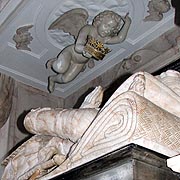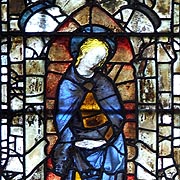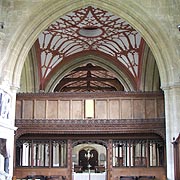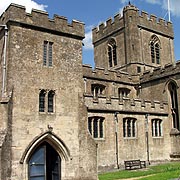
Edington Priory, Wiltshire
 |
 |
 |
 |
Edington is where King Alfred defeated the Vikings in AD 878. The church there has always belonged to Romsey Abbey in Hampshire and it was transformed into a priory in 1358 by William Edington, the Bishop of Winchester, who was born in the village. It was a house of Augustinian Canons (not Bonhommes as sometimes stated) and the present building almost entirely dates from this time: an excellent example of the transition from Decorated to Perpendicular style. Remains of the monastic buildings are incorporated into what is left of the manor house to the north. It was from Edington Priory that the Bishop of Salisbury was dragged and murdered during Jack Cade's rebellion of 1450! The last prior became Bishop of Bristol. His priory church survived because it was also used by the parish. It features a two-storey porch and contains a fine screen of 1500, Atlas-like niche supporters, a few pieces of 14th century glass, medieval marble floors, beautiful Victorian mosaic work and a spiked Jacobean altar-rail to keep the dogs out! There are excellent monuments to knights of the Rous family, an unknown monk with puzzling rebus, Sir Ralph Cheney (1401) with his missing brass and Sir Simon Richard Brissett Taylor sculpted on his deathbed by Sir Francis Chantrey (1815). the star of the show, however, is Lady Beauchamp's monument featuring husband and kneeling children beneath a curtained canopy (1630) from which an extraordinary descending cherub (1664) offers them a crown of glory! The place is also associated with the poetic saint, George Herbert, who was married there in 1629 and the actress/prostitute-cum-Duchess of Bolton, Lavinia Beswick, who is believed to be buried there.
The pictures on this page are cropped examples of images in our high resolution photo library. Please e-mail us for details of these or similar image availability at our very reasonable reproduction rates.